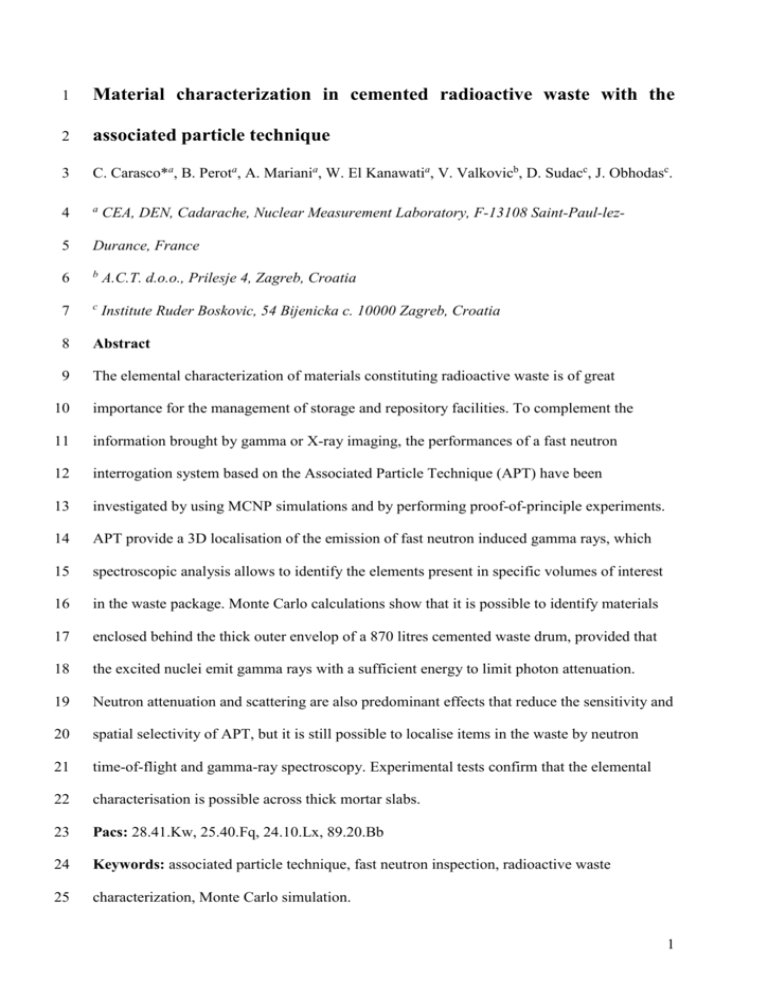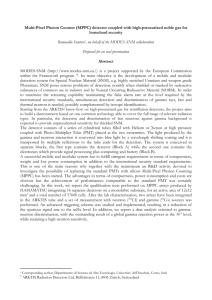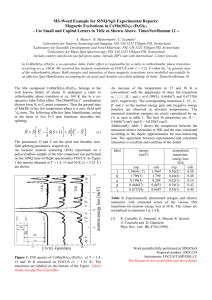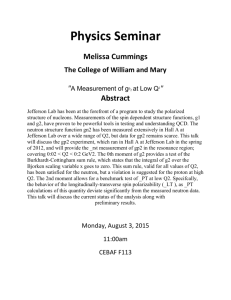Abstract
advertisement

1 Material characterization in cemented radioactive waste with the 2 associated particle technique 3 C. Carasco*a, B. Perota, A. Mariania, W. El Kanawatia, V. Valkovicb, D. Sudacc, J. Obhodasc. 4 a 5 Durance, France 6 b A.C.T. d.o.o., Prilesje 4, Zagreb, Croatia 7 c Institute Ruder Boskovic, 54 Bijenicka c. 10000 Zagreb, Croatia 8 Abstract 9 The elemental characterization of materials constituting radioactive waste is of great CEA, DEN, Cadarache, Nuclear Measurement Laboratory, F-13108 Saint-Paul-lez- 10 importance for the management of storage and repository facilities. To complement the 11 information brought by gamma or X-ray imaging, the performances of a fast neutron 12 interrogation system based on the Associated Particle Technique (APT) have been 13 investigated by using MCNP simulations and by performing proof-of-principle experiments. 14 APT provide a 3D localisation of the emission of fast neutron induced gamma rays, which 15 spectroscopic analysis allows to identify the elements present in specific volumes of interest 16 in the waste package. Monte Carlo calculations show that it is possible to identify materials 17 enclosed behind the thick outer envelop of a 870 litres cemented waste drum, provided that 18 the excited nuclei emit gamma rays with a sufficient energy to limit photon attenuation. 19 Neutron attenuation and scattering are also predominant effects that reduce the sensitivity and 20 spatial selectivity of APT, but it is still possible to localise items in the waste by neutron 21 time-of-flight and gamma-ray spectroscopy. Experimental tests confirm that the elemental 22 characterisation is possible across thick mortar slabs. 23 Pacs: 28.41.Kw, 25.40.Fq, 24.10.Lx, 89.20.Bb 24 Keywords: associated particle technique, fast neutron inspection, radioactive waste 25 characterization, Monte Carlo simulation. 1 1 *Corresponding author: Tel: +33 442256130, Fax: +33 442252367, cedric.carasco@cea.fr 2 1. Introduction 3 The management of radioactive waste is a great concern in countries involved with 4 electronuclear programs [1]. In view of waste repository, the amount of toxic or reactive 5 chemicals must be controlled, Though the production of recent waste includes quality control 6 allowing to know the composition of the drums. However, the content of older wastes 7 remains uncertain. Nuclear non destructive techniques can be used to characterize the 8 radiological content of historical waste, such as passive gamma-ray spectroscopy and neutron 9 measurements [2]. The physical and chemical properties of the waste can be controlled by 10 gamma or X-ray imaging [4], which provide the position, shape and density of the materials, 11 and by “neutron in – gamma out” techniques bringing complementary information about their 12 chemical composition [5,6]. Fast neutron interrogation is a promising technique for large and 13 dense objects [7,8], APT [9] being one of the most sensitive methods. Tagged Neutron 14 Inspection Systems (TNIS) have been recently developed for security applications [11, 12]. 15 During the last decades, CEA has produced a great amount of 870 litres drums filled with 16 radioactive waste blocked in cement. The use of APT to characterize waste materials is a real 17 challenge due to a density close to 2 g.cm-3, much larger than in cargo containers where the 18 average density is around 0.2 g.cm-3 [13]. This paper presents the calculated performances of 19 a TNIS dedicated to 870 litres drums, as well as proof-of-principle experiments to test APT 20 neutron interrogation across thick mortar slabs. 21 2. Numerical simulation 22 The radioactive waste are mixed with cement and placed in an iron drum, an external cement 23 ring blocking this embedded waste, see Fig. 1. Due to aluminium-mortar reactions producing 24 hydrogen, which could weaken the waste matrix, the control of this element is of importance 25 [14]. Fig. 1 shows a 870 litres drum containing a 8 kg aluminium block with a 2.7g.cm-3 2 1 density surrounded by a 2.35 g.cm-3 concrete matrix. The neutron source is shielded with 2 paraffin and lead with an aperture for the tagged beam. Fig. 1 shows that the neutron tagged 3 beam is spread when entering into the drum due to its high density and hydrogen content. 4 Calculation has been preformed with MCNPX and the ENDF-B-VII library. Type 5 tallies 5 estimate the time-energy dependent photon flux at the level of the NaI(Tl) scintillation 6 detectors. In order to obtain realistic spectra, MCNP results are smeared with a 2.1 ns FWHM 7 normal distribution and the 5”×5”×10” NaI(Tl) energy response function [15]. Time spectra 8 associated to the 135° tally are presented in Fig.2. The aluminium density being similar to the 9 one of mortar, the block cannot be distinguished in the time of flight (TOF) spectrum. 10 However, the TOF area of interest can be selected on the basis of γ- or X-ray imaging. By 11 selecting the time region between 31.5 ns and 35 ns geometrically corresponding to the block, 12 the 2.211 MeV aluminium peak is visible in the gamma-ray spectrum, whereas it is not 13 present in the adjacent slice. 14 Another calculation has been performed with a 20cm×20cm×20cm iron box with 0.5 cm thick 15 walls instead of the aluminium block. It is filled with 5 litres of 0.9 g.cm-3 density CH2 to 16 simulate the possible presence of a motor filled with oil in the waste. The presence of organic 17 compounds is indeed a critical issue in alpha bearing waste drums due to hydrogen 18 production [16]. The smeared TOF and energy spectra for the 90° tally are reported in Fig. 3. 19 Oil, which density is smaller than concrete, corresponds to the hollow centred at 36 ns. The 20 associated energy spectrum reveals the presence of carbon, which is not seen in the adjacent 21 slice. 22 3. Experiment 23 To illustrate APT capability, experimental tests have been performed with the EURITRACK 24 system developed within the EU 6th Framework Program [17]. The cemented waste package 25 is simulated with 6 cm thick mortar slabs made with calcium carbonate. For practical reasons, 3 1 the waste mock-up is placed inside a cargo container and sixteen 5”×5”×10” NaI(Tl) gamma- 2 ray detectors located 186 cm above the package are used. This setup, which is not optimal, 3 nevertheless illustrates the ability of the TNIS to detect materials across concrete. A graphite 4 block is placed between the mortar slabs with a 12 cm additional mortar layer to simulate an 5 inspection deep inside a waste package. 6 The 30 min. measurement presented in Fig.4 has been calculated with a 4.107 n.s-1 total 7 neutron emission, from which the tagged neutron beam represents about 1%. On the alpha- 8 gamma coincidence time spectrum, the peak at 13 ns corresponds to materials surrounding 9 the neutron source. The two large peaks located between 20 and 25 ns correspond to the 6 cm 10 and 12 cm mortar layers. The peak at 33 ns is related to the graphite block, followed by the 11 rear mortar wall at 38 ns. The large bump at the end of the spectrum is due to neutrons 12 scattered towards the detectors and to materials located behind the mortar slabs. The net 13 energy spectra corresponding to the hatched areas of the time spectrum have been obtained 14 after subtraction of the random background estimated in negative times and they have been 15 unfolded on the basis of a database formed by the signatures of pure elements [18], allowing 16 the main elements identification. Carbon indicates the presence of the graphite block. The 17 EURITRACK energy threshold was 1.35 MeV when these data were taken. Thus, elements 18 having no characteristic peaks above 1.35 MeV, such as zinc or lead found in Fig. 4, are 19 incorrectly found by the algorithm though they are not present. Such errors have been 20 suppressed since by reducing the threshold to 0.6 MeV and by constructing the corresponding 21 elemental signature database [19]. Nevertheless, low energy photons will be greatly 22 attenuated by the external cement layer of the 870 litres waste drum, thus preventing the 23 detection of elements with only low energy gamma rays. 24 Another test has been performed with aluminium blocks, see Fig. 5. Aluminium is identified 25 on the TOF spectrum between 26 ns and 35 ns, and its gamma rays clearly appear on the 4 1 associated energy spectrum. As previously, the unattended presence of sodium in the 2 unfolding result is a consequence of the 1.35 MeV threshold. Other elements and materials 3 relevant for radioactive waste management, such as chlorine (PVC waste), magnesium, 4 wood, water, and boron have also been investigated, showing other possible applications 5 [20]. 6 4. Conclusion 7 Monte Carlo simulations show that APT allows to identify and locate elements such as 8 carbon and aluminium in a 870 litres drum filled with cemented waste. Preliminary 9 experiments also illustrate the ability of APT to detect materials across thick mortar slabs. 10 Further investigations have to be performed by numerical simulation to study the random 11 background brought by the radiological emission of the waste, as well as counting statistics in 12 a limited acquisition time. Material identification in the middle of the drum will also be 13 studied because neutron attenuation and scattering are expected to significantly deteriorate 14 APT sensitivity and spatial selectivity. On the other hand, the thick concrete envelope 15 surrounding the waste is critical for the detection of low energy gamma rays. Thus, the 16 application of APT to large and dense waste packages can only be envisaged for elements 17 with high energy gamma signatures such as the 2.211 MeV and 4.439 MeV lines of 18 aluminium and carbon, respectively. 19 Acknowledgments 20 The development and implementation of the EURITRACK inspection system has been 21 supported by the European Union through the EURopean Illicit TRAfficking 22 Countermeasures Kit project (FP6-2003-IST-2 Proposal/Contract 511471). We would like to 23 thank the EURITRACK partners who took part in the development and commissioning of the 24 system, namely CEA LIST, INFN, JRC, CAEN, SODERN, IPJ, and KTH, as well as Rijeka 5 1 Seaport and Custom authorities, who allowed that the system be implemented and the 2 measurements be performed on their grounds. 3 References 4 [1] F. Decamps and L. Dujacquier, Overview of European practices and facilities for waste 5 management and disposal, Nucl. Engineering and Design, 176 (1997) 1. 6 [2] B. Perot et al., Experimental qualification with a scale one mock-up of the “measurement 7 and sorting unit” for bituminized waste drums, Proc. of ICEM’03, 9th International 8 Conference on Radioactive Waste Management and Environmental Remediation, 21-25 Sept. 9 2003, Oxford, England. 10 Et le n° [3] ??? 11 [4] JL. Pettier, D. Eck, R. Thierry, "High energy X-ray imaging on large or dense objects: 12 definition and performance studies of devices by simulation", 3rd Int. Conf. on Emerging 13 Technologies in NDT, Thessaloniki Greece, May 2003. 14 [5] J. Kettler, Y. Bai, E. Mauerhofer, R. Nabbi and R. Odoj, Modeling of a prompt gamma 15 neutron activation system for non-destructive determination of toxic elements in radioactive 16 waste packages, Safety research for Nuclear Waste Disposal, Institute for Energy Research, 17 Safety Research and Reactor Technology (IEF-6), Scientific report 2007. 18 [6] F. Jallu, F. loche, Improvement of non-destructive fissile mass assays in a low-level waste 19 drums: A matrix correction method based on neutron capture gamma-rays and a neutron 20 generator, Nucl. Instr. and Meth. B 266 (2008) 3674–3690] 21 [8] A. Buffler. Contraband detection with fast neutrons. Rad. Phys. Chem. 71 (2004) 853. 22 [9] V. Valković, D. Miljanić, P. Tomaś, B. Antolković and M. Furić, Neutron-charged 23 particle coincidence measurements from 14.4 MeV neutron induced reactions, Nucl. Instr. 24 and Meth. 76 (1969) 29. 6 1 [10] G. Viesti et al., Detection of hidden explosives by using tagged neutron beams: Status 2 and perspectives, Nucl. Instr. and Meth. B 241 (2005) 748-752. 3 [11] B. Perot et al., Development of the EURITRACK tagged neutron inspection system, 4 Nucl. Instr. and Meth. B 261 (2007) 295–298. 5 [12] V. Valkovic, New/Future Approaches to Explosive/Chemicals Detection, AIP Conf. 6 Proc. Vol. 1099 (2009) 591-594. 7 [13] J. Obhodas et al., Analysis of Containerized Cargo in the Container Terminal, in this 8 proceedings of ISRP-11 9 [14] S. Freedman, Corrosion of Nonferrous Metals in Contact with Concrete, Modern 10 Concrete 36 (1970). 11 [15] C. Carasco, “Improving MCNP simulation of neutron interrogation systems based on the 12 Associated Particle Technique”, in this proceeding IRSP 2009. 13 [17] C. Carasco, B. Perot, S. Bernard, A. Mariani, J.-L. Szabo, G. Sannie, Th. Roll, V. 14 Valkovic, D. Sudac, G. Viesti, M. Lunardon, C. Bottosso, D. Fabris, G. Nebbia, S. Pesente, 15 S. Moretto, A. Zenoni, A. Donzella, M. Moszynski, M. Gierlik, et al. In-field tests of the 16 EURITRACK tagged neutron inspection system, Nucl. Instr. and Meth. A 588 (2008) 397. 17 [18] B. Perot, C. Carasco, S. Bernard, A. Mariani, J.-L. Szabo, G. Sannie, V. Valković, D. 18 Sudac, G. Viesti, M. Lunardon, et al. Measurement of 14 MeV neutron-induced prompt 19 gamma-ray spectra from 15 elements found in cargo containers, Appl. Radiat. Isot., 20 doi:10.1016/j.apradiso.2007.11.011. 21 [19] W. El Kanawati, C. Carasco, B. Perot, A. Mariani, V. Valkovic, D. Sudac, Improvement 22 of the Calibration Database of the EURITRACK Tagged Neutron Inspection System, to be 23 presented in ANIMMA 2009, Int. Conf. on Advancements in Nucl. Inst., Meas. Meth. and 24 their Appl., 7-10 June 2009, Marseille, Fr. 7 1 [20] C. Carasco, B. Perot, A. Mariani, V. Valkovic, D. Sudac, Use of Associated Particle 2 Technique to Characterize Materials in a Cemented Radioactive Waste Package, 5th 3 International Seminar on Radioactive Waste Products 27 - 31 October 2008, RADWAP 2008, 4 Würzburg (Germany). 5 Figure Captions 6 Figure 1. Numerical model of the neutron inspection interrogation system for 870 L 7 radioactive waste drum. The position of MCNP tallies is represented by the black points 8 placed in front of the NaI(Tl) scintillators. The angles are relative to the tagged neutron beam 9 axis. The dots represent the positions of tagged neutron interactions. 10 Figure 2. TOF spectra associated to the 135° tally without energy cut (full line, top left) and 11 with an energy cut between 2.20 MeV and 2.22 MeV to select the 2.221 MeV aluminium 12 gamma-ray (dashed line, top right), thus revealing the position of the aluminium block 13 between 31.5 ns and 35 ns. After time and energy smearing of the data issued by the 135° 14 tally, TOF spectrum with an energy cut between 2.10 MeV and 2.36 MeV (middle) and 15 energy spectrum obtained with a TOF cut between 31.5 ns and 35 ns (right). 16 Figure 3. TOF spectrum obtained after smearing the time data associated to the 90° tally with 17 a normal distribution having a standard deviation of 0.9 ns (left) , energy spectra obtained 18 when selecting the region between 33 ns and 38 ns (middle) and the region between 29.8 ns 19 and 32.5 ns (right), both time regions being represented in grey area and diagonally hatched 20 lines in the TOF spectrum, respectively. 21 Figure 4. TOF spectrum (top left) associated to the top right setup, showing the mortar front 22 wall (diagonal hatches), graphite block (horizontal hatches), and mortar rear wall (vertical 23 hatches). The corresponding energy spectra (from left to right) and unfolding results highlight 24 the presence of carbon between the mortar blocks. 8 1 Figure 5. TOF spectrum related to the measurement with 42 kg aluminium placed inside the 2 mortar container (left) showing the TOF area associated to the aluminium blocks (horizontal 3 hatched area) and energy spectrum corresponding to the aluminium region (left). 4 5 6 Fig 1 7 8 Fig 2 9 9 1 2 Fig 3 mortar mortar mortar C, 4.439 MeV MeV4.439M EV 3 4 Fig 4 Al, 1.810 MeV Al, 2.211 MeV MeV4.439M MeV4.439M EV EV Al, 3.002 MeV MeV4.439M EV 5 6 Fig. 5 10







